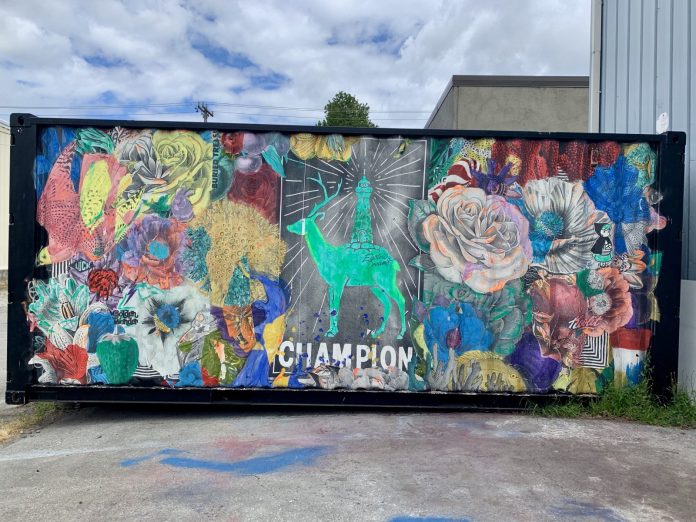
The name “Electric Coffin” may not immediately inspire whimsy, levity, and brightness, but those are exactly the sentiments the art collective Electric Coffin is hoping to seed across Seattle through their exhibit, DISCOVER + DISRUPT at the Center for Architecture and Design on Western Avenue, currently on view through August 31st.
Mindful of urban planning, the exhibit examines Seattle through an art lens. The different concepts presented all funnel back to the same question: how can cities spark wonder and inspire people to question what is possible?
Public art is a vital component of urban placemaking. The presence of art can dramatically change the feeling of a place by bringing unexpected shapes, colors, textures into an otherwise uniform and utilitarian environment. But according to Electric Coffin’s artist statement, art is “often corralled into commercial spaces such as advertisements or limited public art initiatives, unable to infiltrate the rest of city life.”
“So much of the world is trying to sell you things. If you are moving through a city almost every surface has product and a comment on what you should be doing and where you should be going,” said Allie Jones, account supervisor for Electric Coffin.

Through four different movements, or chapters, the DISCOVER + DISRUPT exhibit presents concepts for how art can infiltrate more of city life. Ideas include altruistic billboards, symbolic road signs, shifting perspectives by disrupting linear patterns, and integrating visual unifiers into the landscape, such as multistory knitted installations or yarn bombs.

But those seeking a prescriptive approach to how to build a more whimsical city might be disappointed. “We have more questions than we have solutions and answers,” Jones said. “We are looking for partnership. Our hope is that people will take these ideas and run with them.”
Applying an art lens to urban growth
Electric Coffin is a Seattle based collaborative art studio that explores the intersection of art and commerce. The name comes from artists Duffy De Armas and Stefan Hofmann’s interest in reanimating dead things, a theme that has appeared throughout the collective’s body of work, which often brings new life to discarded objects.
Based in Georgetown, the collective has found inspiration in the industrial, yet neighborly landscape that surrounds their studio. While Georgetown has not seen the same level as gentrification as some other arts focused neighborhoods, like Capitol Hill, it has experienced significant changes, notably a sharp influx in the number of RVs on its streets.

Georgetown’s RVs served as inspiration for one of the exhibit’s most stirring images: a raccoon with an RV on its back. Part of Electric Coffin’s Unio series, the raccoon stirs up questions, indirectly referencing the problem homelessness and economic disparity that has complicated the narrative of Seattle’s recent growth.
The raccoon image is one of the few that feels fully grounded in contemporary Seattle. Many of the ideas put forth in the Discover + Disrupt exhibit are presented in a manner that is more theoretical than tactile, inviting viewers to question how they could be applied in cities.
For readers interesting in learning more specifics about the artist’s vision, on July 16th, Electric Coffin will hold a panel discussion focused on the intersection of art and urban planning. The panel discussion, which will be held from 5pm to 6pm at the Center for Architecture and Design, will also include Matthew McMurray of Treason Gallery and representatives from SDOT.
Natalie Bicknell Argerious (she/her) is a reporter and podcast host at The Urbanist. She previously served as managing editor. A passionate urban explorer since childhood, she loves learning how to make cities more inclusive, vibrant, and environmentally resilient. You can often find her wandering around Seattle's Central District and Capitol Hill with her dogs and cat. Email her at natalie [at] theurbanist [dot] org.


